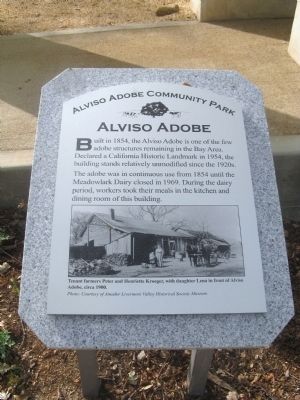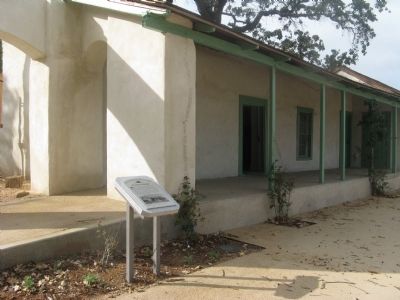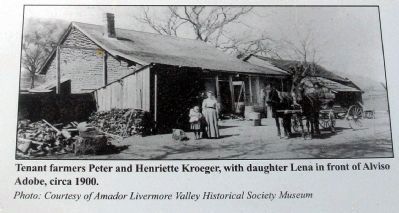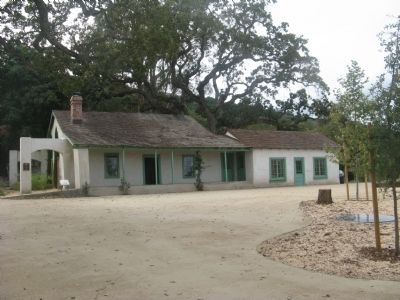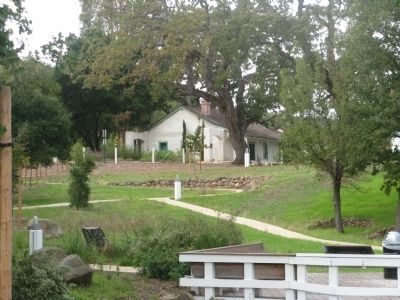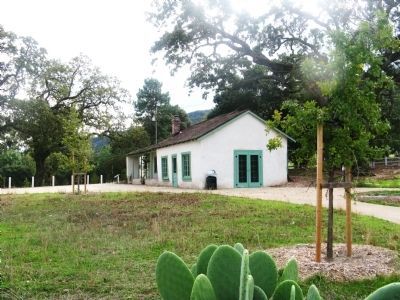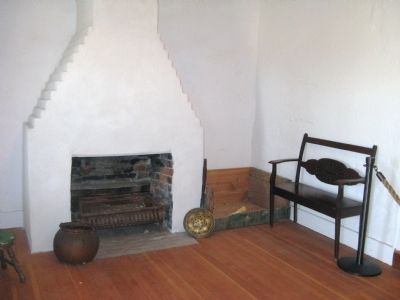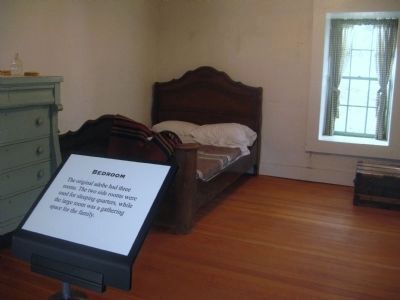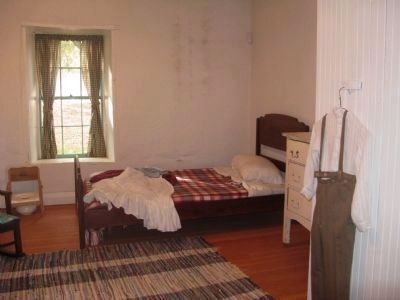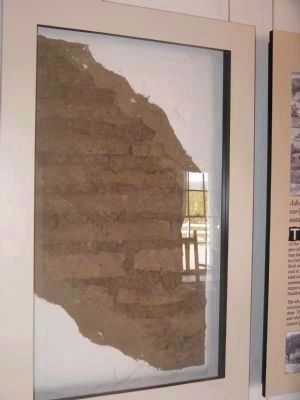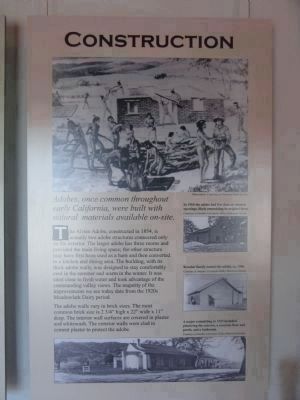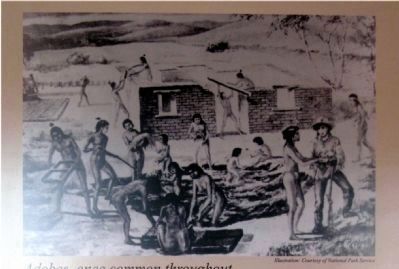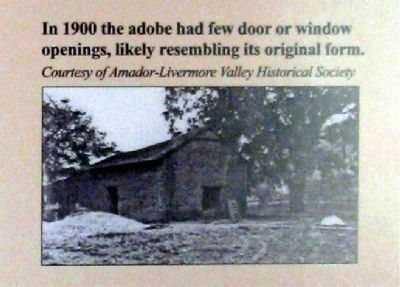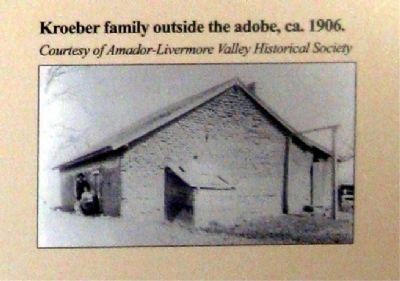Pleasanton in Alameda County, California — The American West (Pacific Coastal)
Alviso Adobe
Alviso Adobe Community Park
The adobe was in continuous use from 1854 until the Meadowlark Dairy closed in 1969. During the dairy period, workers took their meals in the kitchen and dining room of this building.
Erected 2009 by Alviso Community Park. (Marker Number 510.)
Topics and series. This historical marker is listed in these topic lists: Agriculture • Industry & Commerce • Notable Buildings • Settlements & Settlers. In addition, it is included in the California Historical Landmarks series list. A significant historical year for this entry is 1854.
Location. 37° 39.624′ N, 121° 54.744′ W. Marker is in Pleasanton, California, in Alameda County. Marker can be reached from Old Foothill Road near Foothill Road. Marker is located next to the Adobe. Touch for map. Marker is at or near this postal address: 3465 Old Foothill Road, Pleasanton CA 94588, United States of America. Touch for directions.
Other nearby markers. At least 8 other markers are within 2 miles of this marker, measured as the crow flies. Alviso Adobe Community Park (within shouting distance of this marker); Meadowlark Dairy - The Dairy Silo (within shouting distance of this marker); Meadowlark Dairy (within shouting distance of this marker); Changing Landscape (within shouting distance of this marker); Meadowlark Dairy – Dairy Manager’s House (about 400 feet away, measured in a direct line); Meadowlark Dairy – Dairy Bunkhouse (about 400 feet away); Meadowlark Dairy - Historic Orchard (about 400 feet away); The Heritage House (approx. 1½ miles away). Touch for a list and map of all markers in Pleasanton.
Additional commentary.
1. Rancho Santa Rita
The first documented inhabitants of the land were the Ohlone People. Hard rock mortars are still found on the site.
In 1797 Mission San Jose was established.
In 1821 Mexico received its independence from Spain and the Missions were secularized and the Mission lands were given as land grants to favored Mexican citizens. In 1839 the Amador-Livermore Valley, formally grazing land of the Mission San Jose, was divided up into four large rancheros; Rancho San Ramon, Rancho Las Positas, Rancho el Valle de San Jose and this area, Rancho Santa Rita. The grantee, Jose Pacheco never lived on the ranchero, choosing to keep his residence in San Jose. In the early 1850’s this area was acquired by Francisco Solano Alviso and in 1854 this adobe was built.
By 1881 ownership had changed again and the local water company assumed ownership. The land was occupied by tenant farmers. In 1919 the Meadowlark Diary began operations on the site. In 1969 the dairy operations ceased and in 1993 the land was acquired by the City of Pleasanton and in 2008 the Alviso Adobe Community Park was opened.
— Submitted November 17, 2009, by Syd Whittle of Mesa, Arizona.
2. Description on Informative Panel Seen in Photo #11
Adobes, once common throughout early California, were built with materials available on-site
The Alviso Adobe, constructed in 1854, is actually two adobe structures connected only on the exterior. The larger adobe has three rooms and provided the main living space; the other structure may have first been used as a barn and then converted to a kitchen and dining area. The building, with its thick adobe walls, was designed to stay comfortably cool in the summer and warm in the winter. It was sited close to fresh water and took advantage of the commanding valley views. The majority of the improvements we see today date from the 1920s Meadowlark Dairy period.
The
adobe walls vary in brick sizes. The most common brick size in 2 3/4" high x 22" wide x 11" deep. The interior wall surfaces are covered in plaster and whitewash. The exterior walls were clad in cement plaster to protect the adobe.
— Submitted November 17, 2009, by Syd Whittle of Mesa, Arizona.
3. Additional Informative Panels
In addition to the Informative Panel seen in Photo #11, there are three other panels on display. The first details the restoration of the adobe, the second one highlights the California Ranchos and the third is of the Ranch Families. Photos also accompany the text on these panels.
Restoration:
Over time, the Alviso Adobe was modified to meet the needs of its occupants. The structure suffered some damage in the 1906 San Francisco Earthquake and concrete arches were added to buttress the south wall. The building’s biggest changes occurred in the 1920s when it became an integral part of the dairy operation and was modified to provide shower/toilet facilities, a kitchen and dining area for workers.
Since the 1920s very few changes have been made to the building. Unoccupied since the late 1960s, the adobe fell into disrepair. A major stabilization effort by the City of Pleasanton in the late 1990s halted further deterioration. Recent improvements include seismic stabilization, some structural reinforcement, a new roof, restoration of the bathroom and shower area, and rehabilitation of interior finishes to evoke the building’s 1920 character.
California Ranchos
Ranchos and cattle formed the backbone of early California’s economy. The historic Alviso Adobe represents a type of building typically found during the Californios period, after the Missions disbanded in the 1830s. The missions offered parcels of pasture land to qualified applicants. Requirements to gain title to a land grant were to build cattle corrals, a dwelling and to plant an orchard.
The main marketable item produced on the ranches were cattle. For the Indians who had been under the guide of mission priests, life on the ranchos was similar to what it had been with the missions. They tended herds and helped raise crops.
Ranch Families
From 1880 up until 1919, the property was leased for tenant farming. Peter and Henrietta Kroeger leased the Alviso Adobe from 1899 to 1912. Use of the land seems to have shifted from animal husbandry to farmstead during this time.
Walter M. Briggs bought the property in April 1919 and developed it into the Meadowlark Dairy. Robert H. Dana became the manager, accompanied by his wife Sarah. As a young girl, their daughter Doris Dana Tobias began participating in the dairy’s operation milking, pasteurizing, and bailing hay.
Jannes and Janna Takens, who came from Holland, began working at the dairy in 1950. They leased the Meadowlark Dairy from 1960 – 1969.
— Submitted November 18, 2009, by Syd Whittle of Mesa, Arizona.
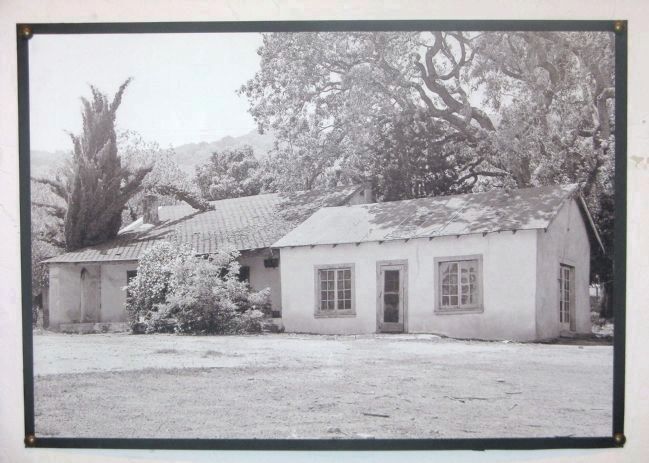
16. Alviso Adobe
This photo is on display at the "Museum on Main Street"
The left section of the building is the original adobe. The right section is the former barn which later was converted to a kitchen and dining area.
"The Francisco Alviso Adobe is located on lands that were once part of Rancho Santa Rita, first granted to Jose Delores Pacheco in 1839. The Alviso family purchased the land and built the existing adobe in 1854. Francisco Alviso and his wife Miranda raised their 12 children at this site. In an agricultural census from 1860, Mr. Alviso stated that he owned 200 acres of unimproved land, 7 horses, 30 milch cows, and 100 other cattle. Archival research suggests that he was running a dairy, possibly the first in the area"
Source: The Museum on Main Street Display
"The Francisco Alviso Adobe is located on lands that were once part of Rancho Santa Rita, first granted to Jose Delores Pacheco in 1839. The Alviso family purchased the land and built the existing adobe in 1854. Francisco Alviso and his wife Miranda raised their 12 children at this site. In an agricultural census from 1860, Mr. Alviso stated that he owned 200 acres of unimproved land, 7 horses, 30 milch cows, and 100 other cattle. Archival research suggests that he was running a dairy, possibly the first in the area"
Source: The Museum on Main Street Display
Credits. This page was last revised on June 16, 2016. It was originally submitted on November 16, 2009, by Syd Whittle of Mesa, Arizona. This page has been viewed 2,644 times since then and 48 times this year. It was the Marker of the Week December 13, 2009. Photos: 1, 2. submitted on November 16, 2009, by Syd Whittle of Mesa, Arizona. 3. submitted on November 17, 2009, by Syd Whittle of Mesa, Arizona. 4. submitted on November 16, 2009, by Syd Whittle of Mesa, Arizona. 5. submitted on November 17, 2009, by Syd Whittle of Mesa, Arizona. 6. submitted on November 16, 2009, by Syd Whittle of Mesa, Arizona. 7, 8, 9, 10, 11, 12, 13, 14, 15, 16. submitted on November 17, 2009, by Syd Whittle of Mesa, Arizona.
